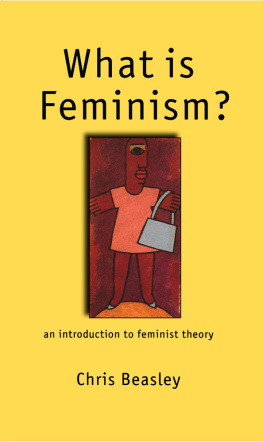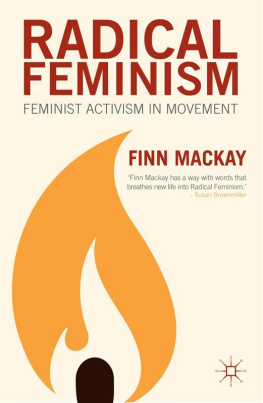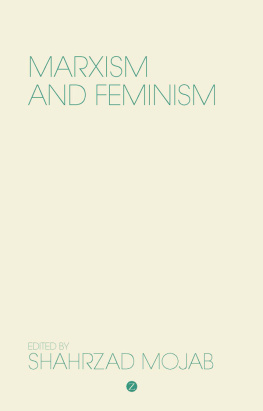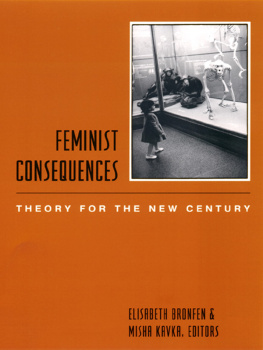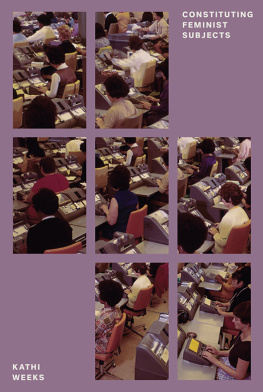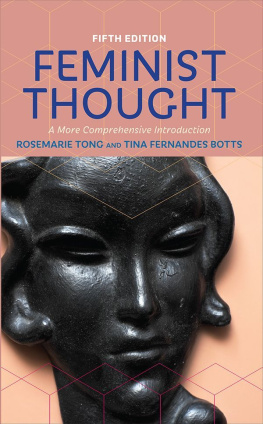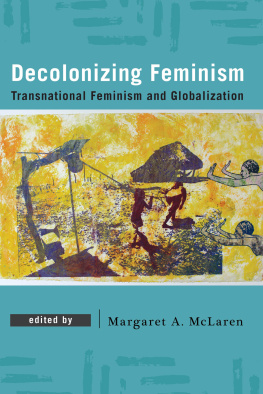Copyright Chris Beasley, 1999
First published in 1999 by
Allen & Unwin
9 Atchison Street
St Leonards NSW 1590
Australia
All rights reserved. No part of this book may be reproduced or transmitted in any form or by any means, electronic or mechanical, including photocopying, recording or by any information storage and retrieval system, without prior permission in writing from the publisher.
| SAGE Publications Ltd 6 Bonhill Street London EC2A 4PU |
SAGE Publications Inc 2455 Teller Road Thousand Oaks, California 91320 SAGE Publications India Pvt Ltd 32, M-Block Market Greater KailashI New Delhi 110 048 |
British Library Cataloguing in Publication data
A catalogue record for this book is available from the British Library
ISBN 978-0-7619-6334-9 (hbk)
ISBN 978-0-7619-6335-6 (pbk)
Library of Congress catalog record available
10 9 8 7 6 5 4 3 2 1
Introduction
Feminism is a troublesome term. It may conjure up images of lively discussions, gesticulating hands and perhaps the occasional thumping of fists on tables; certainly, hot milk and bedsocks do not spring to mind. And yet, while the term appears to encourage a great many people to express opinions, it is by no means clear what is being talked about.
Such lack of clarity is not a straightforward result of either limited knowledge or prejudiced misrepresentation. Feminism is one of those terms that inconveniently defy simple explanation. Moreover, feminisms complexity and diversity provide obstacles to those wishing to gain a satisfactory grasp of its meanings. This interesting and powerful combination initially suggested to me the need for a short, comprehensive and intellectually rigorous book, a book which could deal with the question of what characterises contemporary Western feminism. I chose the somewhat impatient query, What is feminism anyway?, as the appropriate title for this book in order to signal my growing perception that although the term feminism is commonly used it is, at the same time, both confusing and difficult.
This book is intended to be used as a helpful, condensed but thorough reference by those of you who are new to the field as well as those who are already well informed. It offers both analysis and a surveyan accessible, short-cut through the swathe of writing dealing with feminism. After reading the book you should be able to launch into a discussion on the subject of feminism with some degree of confidence.
THE PROBLEM
Feminism is becoming an increasingly accepted part of ordinary social and political discourse, even if it is not viewed in the same light by everyone. However, feminism now, as in the past, entails a variety of widely differing approaches. And yet, in spite of this diversity, feminism is often represented in everyday discussions, as well as in lecture rooms, as a single entity and somehow concerned with equality. This limited portrayal is rarely challenged, partly because many forms of current feminist analysis require considerable previous knowledge and are sometimes only available in forms of academic language so difficult that they make Einsteins theory of relativity look like a piece of cake. Contemporary feminist thought has sometimes, in this context, been accused of retreating from broadly understandable language into an incomprehensible jargon typically associated with ivory tower academics.
Whether this accusation is fair or not, the problem remains that despite a growing awareness of and potential audience for feminist ideas, feminist thought is little understoodeven among academics. I have been lecturing in the field of feminist thought for well over a decade and have recently been struck by the ever increasing number of students and staff from other courses and disciplines asking me for assistance. It is both a pleasing and dispiriting development. On the one hand, academic teachers wish to include some reference to feminist approaches in their subjects and, relatedly, students are now often required or wish to write on topics involving women, gender issues, bodies, sexuality, et cetera. On the other hand, teachers within universities and in other settings find that it is no simple matter to gather together the resources necessary for even the most basic inclusion of contemporary feminist frameworks in their subjects. And students ask for assistance because, while there may be some discussion of feminism in the courses they undertake, the material provided typically either assumes feminism is equivalent to (North American) liberal feminism or hints gloomily at the hardships involved in coming to grips with contemporary feminist thought without much further clarification. The problems associated with gaining some understanding of the term feminism are usually even greater for those outside educational institutions. In this context, teachers, students and other interested individuals obviously require some reasonably quick, painless and relatively straightforward guide through the complexity of the field.
A close look at the range of materials commonly employed by teachers attending to feminism goes some way to explaining why it is actually quite difficult to gain a satisfactory grasp of the field. Although feminist thought has been considered by many authors, existing writers rarely attend to the issue of what it is they are discussing. The meaning of the term feminism is almost invariably assumed and/or evaded. Furthermore, most texts dealing with contemporary Western feminism tend to deal only with some aspects of feminismsuch as focusing on more established (modernist) approaches, or only summarising various types of thought named feminist (which does not explain why they are so named). The result is that those who hope to become better informed about feminism have little choice but to struggle through several texts and try to develop some perspective of their own.
While I do not for one moment suggest that wide reading or the process of attempting to figure out the characteristics of a field of knowledge are undesirable, there is no doubt that most of us face restrictions on the time and energy necessary to devote to these forms of intellectual preparation. Moreover, I see no reason why finding out about feminist thought has to be such a chore. On these grounds there seemed to me a definite place for a book which provides a reasonably accessible analytical guide in one site. This book is not supposed to replace wider reading but it is intended to make that reading more efficient and less agonising.
The book clarifies the question of what contemporary Western feminism involves and thus offers a definition of the term. The notion of defining feminism is controversial.feminists themselves often indicate considerable reluctance to engage in the task of definition. In the main, feminists are inclinedfrequently deliberatelynot to define what they mean by feminism, sensing dangers such as internal policing of both the field and of feminists by those who might like to determine what is to be included (or not), as well as the potential danger of constricting the unstable vitality of its meanings.

